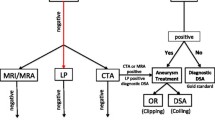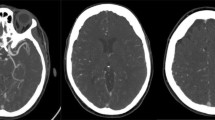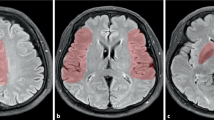Summary
Cerebral vasodilatory capacity was evaluated by acetazolamide-activated N-isopropyl-p-[12 3I]iodoamphetamine (123I-IMP) single photon emission computed tomography (SPECT) in 42 patients with subarachnoid haemorrhage (SAH).
A low perfusion area was present in the corresponding region of haematoma seen on the CT and continued to be noted throughout the time courses. Deteriorated acetazolamide reactivity affected by surgical intervention was seen in 100% of the patients who underwent aneurysm repair in the 1st postoperative week, 92% in the second week, 73% in the third week, and 47% in the fourth week. Three patients with acute diffuse brain swelling seen on CT showed intracranial non-filling of123I-IMP on SPECTs performed on Day 6, and all three died by Day 10.
Some low perfusion areas, due to probable vasospasm, were present in 77% of Hunt and Hess grades I and II patients and in 100% of grades III, IV, and V patients throughout their time courses. Overall, low perfusion areas, due to probable vasospasm, were seen in 10 patients (31%) of 32 who underwent SPECT between Day 4 and 8, 23 (77%) of 30 between Day 9 and 14, 21 (72%) of 29 between Day 15 and 21, and 11 (48%) of 23 between Day 22 and 28.
The results suggest acetazolamide-activated123I-IMP study is of value in evaluating changes in vasodilatory capacity in SAH patients in the acute and subacute stages.
Similar content being viewed by others
References
Baron JC, Bousser MG, Comar D, Castaigne P (1980) “Crossed cerebellar diaschisis” in human supratentorial brain infarction. Ann Neurol 8: 128
Fisher CM, Kistler JP, Davis JM (1980) Relation of cerebral vasospasm to subarachnoid hemorrhage visualized by computerized tomographic scanning. Neurosurgery 6: 1–9
Harders AG, Gilsbach JM (1987) Time course of blood velocity changes related to vasospasm in the circle of Willis measured by transcranial Doppler ultrasound. J Neurosurg 66: 718–728
Hasegawa Y, Yamaguchi T, Tsuchiya T, Moriyasu H, Nishimura T (1989) The effect of acetazolamide on electroencephalogram and somatosensory evoked potential in patients with major cerebral artery occlusion. No Socchu 11: 592–599
Hassler W, Chioffi F (1989) CO2 reactivity of cerebral vasospasm after aneurysmal subarachnoid haemorrhage. Acta Neurochir (Wien) 98: 167–175
Højer-Pedersen E (1987) Effect of acetazolamide on cerebral blood flow in subacute and chronic cerebrovascular disease. Stroke 18: 887–891
Holl K, Heissler HE, Nemati N, Gaab MR, Haubitz B, Becker H (1990) Die Wirkung der Acetazolamin-induzierten, endogenen Volumenbelastung des zerebrospinalen Systems auf den intrakraniellen Druck. DIAMOX®-Wirkung auf den intrakraniellen Druck (ICP). Neurochirurgia (Stuttg) 33: 29–36
Hunt WE, Hess RM (1968) Surgical risk as related to time of intervention in the repair of intracranial aneurysms. J Neurosurg 28: 14–20
Knuckey NW, Fox RA, Surveyor I, Stokes BAR (1985) Early cerebral blood flow and computerized tomography in predicting ischemia after cerebral aneurysm rupture. J Neurosurg 62: 850–855
Kuhl DE, Barrio JR, Huang SC, Selin C, Ackermann RF, Lear JL, Wu JL, Lin TH, Phelps ME (1982) Quantifying local cerebral blood flow by N-isoprypyl-p-[123I]iodoamphetamine (IMP) tomography. J Nucl Med 23: 196–203
Kuhl DE, Phelps ME, Kowell AP, Metter EJ, Selin C, Winter J (1980) Effects of stroke on local cerebral metabolism and perfusion: mapping by emission computed tomography of18FDG and13NH3. Ann Neurol 8: 47–60
Kuroda S, Takigawa S, Kamiyama H, Abe H, Sakuragi M, Motomiya M, Nakagawa T, Mitsumori K, Tsuru M (1990) Diagnosis of hemodynamic compromise in patients with chronic cerebral ischemia; The detection of impaired vasodilatory capacity with133Xe SPECT and acetazolamide (Diamox) test. No Shinkei Geka 18: 167–173
Lassen NA (1966) The luxury perfusion syndrome and its possible relation to acute metabolic acidosis localized within the brain. Lancet 2: 1113–1115
Lassen NA, Friberg L, Kastrup T, Rizzi D, Jensen JJ (1987) Effects of acetazolamide on cerebral blood flow and brain tissue oxygenation. Postgrad Med J 63: 185–187
Lenzi GL, Frackowiak RSJ, Jones T (1982) Cerebral oxygen metabolism and blood flow in human cerebral ischemic infarction. J Cereb Blood Flow Metabol 2: 321–335
Metter EJ, Wasterlain CG, Kuhl DE, Hanson WR, Phelps ME (1981)18FDG positron emission computed tomography in a study of aphasia. Ann Neurol 10: 173–183
Meyer CH, Lowe D, Meyer M, Richardson PL, Neil-Dwyer G (1983) Progressive change in cerebral blood flow during the first three weeks after subarachnoid haemorrhage. Neurosurgery 12: 58–76
Mickey B, Vorstrup S, Voldby B, Lindewald H, Harmsen A, Lassen NA (1984) Serial measurement of regional cerebral blood flow in patients with SAH using133Xe inhalation and emission computerized tomography. J Neurosurg 60: 916–922
Nakagawara J, Wada K, Takeda R, Usami T, Hashimoto I, Shimazaki M, Tanaka C, Nakamura J, Suematsu K (1989) Prediction of cerebral ischemia due to cerebral vasospasm in SAH using SPECT and123I-IMP with acetazolamide test. No Socchu No Geka 17: 301–307
Nishikawa M, Handa H, Hirai O, Kaneko T, Munaka M, Watanabe S, Fukuma A (1989) Pathophysiology and prognosis of patients with ruptured intracranial aneurysm. No Socchu No Geka 17: 95–99
Olsen ST, Lassen NA (1984) A dynamic concept of middle cerebral artery occlusion and cerebral infarction in the acute stage based on interpreting severe hyperemia as a sign of embolic migration. Stroke 15: 458–468
Saito I, Ueda Y, Sano K (1977) Significance of vasospasm in the treatment of ruptured intracranial aneurysms. J Neurosurg 47: 412–429
Sorteberg W, Lindegaard K-F, Rootwelt K, Dahl A, Nyberg-Hansen R, Russell D, Nornes H (1989) Effect of acetazolamide on cerebral artery blood velocity and regional cerebral blood flow in normal subjects. Acta Neurochir (Wien) 97: 139–145
Sullivan HG, Kingsbury IV TB, Morgan ME, Jeffcoat RD, Allison JD, Goode JJ, McDonnell DE (1987) The rCBF response to Diamox in normal subjects and cerebrovascular disease patients. J Neurosurg 67: 525–534
Sunada I (1989) Measurement of cerebral blood flow by single photon emission computed tomography in cases of internal carotid artery occlusion. Neurol Med Chir (Tokyo) 29: 496–502
Ueda T, Kinoshita K, Watanabe K, Hoshi H (1986) Local cerebral blood flow measurement by SPECT using123I-IMP in patients with occlusive cerebrovascular disease. Neurol Med Chir (Tokyo) 26: 601–607
Voldby B, Enevoldsen EM, Jensen JT (1985) Regional CBF, intraventricular pressure, and cerebral metabolism in patients with ruptured intracranial aneurysms. J Neurosurg 62: 48–58
Vorstrup S, Brun B, Lassen NA (1986) Evaluation of the cerebral vasodilatory capacity by the acetazolamide test before EC; IC bypass surgery in patients with occlusion of the internal carotid artery. Stroke 17: 1291–1298
Wilkinson HA (1989) Cerebral blood flow response to acetazolamide. J Neurosurg 70: 156
Winchell HS, Baldwin RM, Lin TH (1980) Development of I-123-labeled amines for brain studies: Localization of I-123 iodophenylalkyl amines in rat brain. J Nucl Med 21: 940–946
Winchell HS, Horst WD, Braun L, Oldendorf WH, Hattner R, Parker H (1980) N-isopropyl-[123I]p-iodoamphetamine: Single-pass brain uptake and washout; binding to brain synaptosomes; and localization in dog and monkey brain. J Nucl Med 21: 947–952
Yamada T, Shima T, Okada Y, Nishida M, Yamane K, Okita S, Yoshida A (1989) Evaluation of vasospasm using transcranial Doppler sonography and single photon ECT. No Socchu No Geka 17: 308–312
Yamagata S, Kikuchi H, Ihara I, Nagata I, Morooka Y, Naruo Y, Koizumi T, Hashimoto K, Minamikawa J, Miyamoto S (1987) Cerebral blood flow in subarachnoid haemorrhage: Analysis in patients with poor outcome. No Shinkei Geka 15: 1189–1196
Yamakami I, Isobe K, Yamaura A, Nakamura T, Makino H (1983) Vasospasm and regional cerebral blood flow (rCBF) in patients with ruptured intracranial aneurysm: Serial rCBF studies with the Xenon-133 inhalation method. Neurosurgery 13: 394–401
Author information
Authors and Affiliations
Rights and permissions
About this article
Cite this article
Shinoda, J., Kimura, T., Funakoshi, T. et al. Acetazolamide reactivity on cerebral blood flow in patients with subarachnoid haemorrhage. Acta neurochir 109, 102–108 (1991). https://doi.org/10.1007/BF01403003
Issue Date:
DOI: https://doi.org/10.1007/BF01403003




